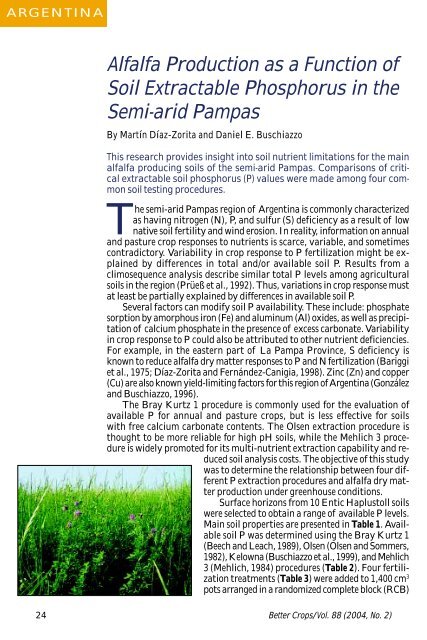Better Crops 2004 #2 - International Plant Nutrition Institute
Better Crops 2004 #2 - International Plant Nutrition Institute
Better Crops 2004 #2 - International Plant Nutrition Institute
Create successful ePaper yourself
Turn your PDF publications into a flip-book with our unique Google optimized e-Paper software.
ARGENTINA<br />
Alfalfa Production as a Function of<br />
Soil Extractable Phosphorus in the<br />
Semi-arid Pampas<br />
By Martín Díaz-Zorita and Daniel E. Buschiazzo<br />
This research provides insight into soil nutrient limitations for the main<br />
alfalfa producing soils of the semi-arid Pampas. Comparisons of critical<br />
extractable soil phosphorus (P) values were made among four common<br />
soil testing procedures.<br />
T<br />
he semi-arid Pampas region of Argentina is commonly characterized<br />
as having nitrogen (N), P, and sulfur (S) deficiency as a result of low<br />
native soil fertility and wind erosion. In reality, information on annual<br />
and pasture crop responses to nutrients is scarce, variable, and sometimes<br />
contradictory. Variability in crop response to P fertilization might be explained<br />
by differences in total and/or available soil P. Results from a<br />
climosequence analysis describe similar total P levels among agricultural<br />
soils in the region (Prüeß et al., 1992). Thus, variations in crop response must<br />
at least be partially explained by differences in available soil P.<br />
Several factors can modify soil P availability. These include: phosphate<br />
sorption by amorphous iron (Fe) and aluminum (Al) oxides, as well as precipitation<br />
of calcium phosphate in the presence of excess carbonate. Variability<br />
in crop response to P could also be attributed to other nutrient deficiencies.<br />
For example, in the eastern part of La Pampa Province, S deficiency is<br />
known to reduce alfalfa dry matter responses to P and N fertilization (Bariggi<br />
et al., 1975; Díaz-Zorita and Fernández-Canigia, 1998). Zinc (Zn) and copper<br />
(Cu) are also known yield-limiting factors for this region of Argentina (González<br />
and Buschiazzo, 1996).<br />
The Bray Kurtz 1 procedure is commonly used for the evaluation of<br />
available P for annual and pasture crops, but is less effective for soils<br />
with free calcium carbonate contents. The Olsen extraction procedure is<br />
thought to be more reliable for high pH soils, while the Mehlich 3 procedure<br />
is widely promoted for its multi-nutrient extraction capability and reduced<br />
soil analysis costs. The objective of this study<br />
was to determine the relationship between four different<br />
P extraction procedures and alfalfa dry matter<br />
production under greenhouse conditions.<br />
Surface horizons from 10 Entic Haplustoll soils<br />
were selected to obtain a range of available P levels.<br />
Main soil properties are presented in Table 1. Available<br />
soil P was determined using the Bray Kurtz 1<br />
(Beech and Leach, 1989), Olsen (Olsen and Sommers,<br />
1982), Kelowna (Buschiazzo et al., 1999), and Mehlich<br />
3 (Mehlich, 1984) procedures (Table 2). Four fertilization<br />
treatments (Table 3) were added to 1,400 cm 3<br />
pots arranged in a randomized complete block (RCB)<br />
24 <strong>Better</strong> <strong>Crops</strong>/Vol. 88 (<strong>2004</strong>, No. 2)

















